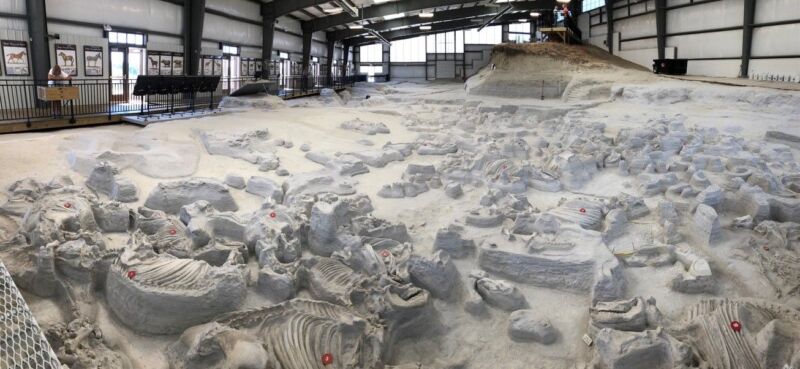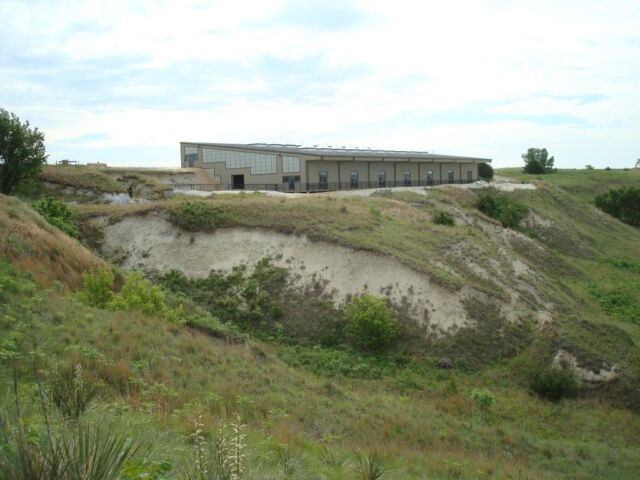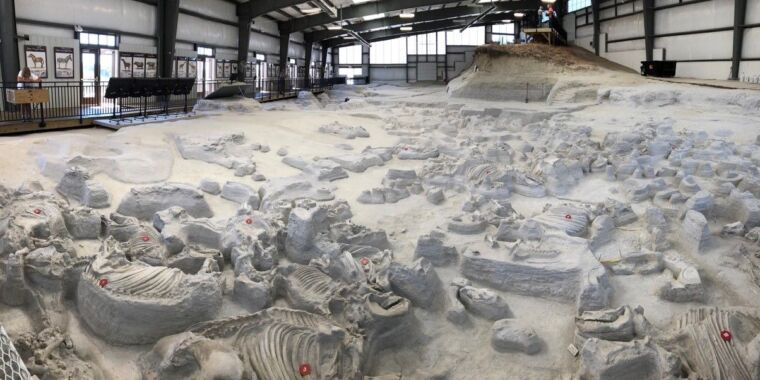
Rick E. Otto, University of Nebraska State Museum
Death was everywhere. Animal bodies were strewn across the landscape and trapped in the local waterhole as ash engulfed everything in its path. For some, death was quick; for others, it was slow and painful.
This was the scene after a supervolcano erupted in Idaho, about 1,600 kilometers (900 miles) away. It was an eruption so powerful that it obliterated the volcano itself, creating a crater 80 kilometers (50 miles) wide and sending ash plumes that were carried by the wind for great distances, killing almost everything that breathed it. This was especially true here, at this location in Nebraska, where animals large and small succumbed to the deadly emissions from the eruption.
Eventually, all traces of this terrible event were buried; life continued, evolving and changing. That is why, millions of years later, in the summer of 1971, Michael Voorhies was able to enjoy another glorious day of exploration.
Finding Rhinos
He was, as he did every summer between academic years, making a geological map of his Nebraska hometown. This meant going from farm to farm, asking to walk the property to examine rocks and look for fossils. “I'm just a kid at heart, and being a paleontologist in the summer was my idea of heaven,” Voorhies, now retired from the University of Georgia, told Ars.
What caught his eye on one particular farm was a layer of volcanic ash, something that geologists and paleontologists treasure to help them determine the age of deposits. But as he got closer, he also saw exposed bone. “Finding what was clearly a lower jaw still attached to the skull, that was really interesting!” he said. “Usually you find isolated bones and teeth.”
That skull belonged to a young rhino. Voorhies and several of his students returned to the site to dig further, and discovered the rest of the rhino’s fully articulated remains (meaning the bones of its skeleton were connected as they would be in real life). More digging yielded the intact skeletons of five or six more rhinos. That was enough to earn National Geographic funding for a massive excavation that took place between 1978 and 1979. Crews collected a remarkable total of 70 complete rhino skeletons, among countless other animals.
To put this in perspective, most fossil sites, even spectacular ones where multiple animals are preserved, consist largely of dismembered skeletons, puzzle pieces that paleontologists have laboriously put back together. Here, however, was something no other site had ever yielded before: vast numbers of complete skeletons preserved where they had died.
When Voorhies and others realized there was more to discover, they called on the greater Nebraska community to help preserve the area. Thanks to hard work and significant local donations, the Ashfall Fossil Beds park opened to the public in 1991, with two full-time employees.
Recovered fossils are now left in situ, meaning they remain exactly where they were found, protected by a massive structure called the Hubbard Rhino Barn. Excavations at the barn are much slower and more steadier than they were in the 1970s, largely because of the small, rotating number of seasonal workers—mostly students—who dig further each summer.

Photos by Rick E. Otto, University of Nebraska State Museum
A complete ecosystem
Nearly 50 years of excavation and research have revealed the story of a catastrophic event and its aftermath that took place in a Nebraska no one would recognize, a place where species like rhinoceroses, camels and saber-toothed deer were an everyday sight.
But to understand that story, we need to set the scene. The area we now know as the Ashfall Fossil Beds was actually a Miocene waterhole, one that was frequented by a variety of animals. We know this because there are fossils of those animals in a layer of sand at the very bottom of the waterhole, a layer that was unaffected by the supervolcanic eruption.
Rick Otto was one of the students who unearthed the fossils in 1978. He became Ashfall's superintendent in 1991 and retired at the end of 2023. “There were animals dying of natural causes around the Ashfall waterhole before the volcanic ash storm happened,” Otto told Ars, which explains the fossils found in that sand. After they were eaten, their bodies may have been trampled by some of the megafauna that frequented the waterhole, which “would have worked those bones into the sand.”

